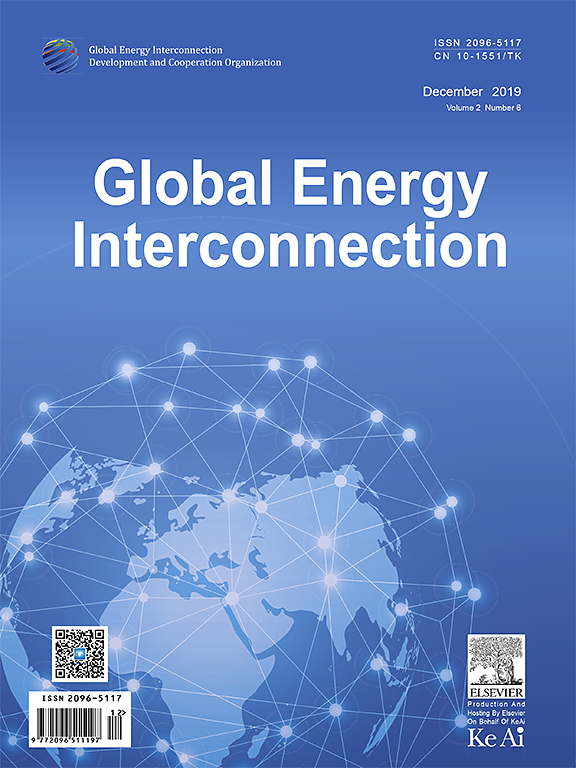Recommended articles:
-

-
Global Energy Interconnection
Volume 5, Issue 5, Oct 2022, Pages b1
A special issue “Planning,modelling and operation of modern power systems” of Global Energy Interconnection Journal
Keywords
Abstract
Modern power systems (PSs) are among the most globally widespread technical systems in terms of both territorial scale and the level of involvement in various spheres of human life.This is primarily because electrical energy is a universal energy carrier that has multiple applications,including industrial production,transport (particularly,charging of electric vehicles),agriculture,information and communication,residential-commercial sector,and cultural sphere.
Global electricity consumption has increased over the entire period of the existence of the electric power industry as an independent industry and,accordingly,has led to the development of electric PSs as a technological infrastructure that encompasses the generation,transportation,distribution,sales,and consumption of electrical energy.From 1990 to the present,global electricity consumption has increased by approximately 2.5 times and has reached almost 25 trillion kWh in 2021.Concurrently,some downturns in electricity demand are inevitable,such as those caused by the global COVID-19 pandemic in 2020 or the global economic crisis in 2009.
There is an evident upward trend in the share of electricity consumption in the total energy consumption.For example,since 2000,this share has increased from approximately 16% to more than 20% and is projected to reach approximately 28% by 2040.In this regard,the growth in the demand for electrical energy is expected to continue in the future,even in the context of a general stagnation in energy consumption;this necessitates significant modernization and further development of electric PSs.
In the course of their evolution,electric PSs have undergone various technological and organizational transformations.They were initially based on direct current (DC) technology.Electricity was produced at a low-voltage DC and distributed at this voltage to consumers.The territorial coverage of such PSs was small and limited by high electricity transmission losses at low voltages;therefore,these systems were local in nature.The capacity of generating sources,in turn,was also constrained by the consumer demand for electricity met by the local PS.
With the adoption of alternating current (AC) technology in the electric power industry,a new concept of electric PSs was introduced,and this remains relevant at present.These systems entail producing electricity at a low voltage,then increasing the voltage using transformers,and transmitting electricity at a high voltage over long distances (with relatively small losses).Then the reverse transformation takes place,and electricity is distributed to consumers at a low voltage.The AC PSs thus built proved to be more efficient than the DC PSs and hence replaced the latter.
Thereafter,the PSs of Europe started to use an AC frequency of 50 Hz,while that of North America adopted 60 Hz.In South America,a few countries (Argentina,Chile,Uruguay,Paraguay,and Bolivia) used a frequency of 50 Hz,while others (Brazil,Venezuela,Colombia,Peru,and Ecuador)adopted 60 Hz.In Japan,different parts of the country imported power-generating equipment from Europe and the USA,which operated at frequencies of 50 Hz and 60 Hz,respectively.Initially,the local PSs were not expected to actively expand and gradually transform into large PSs covering the entire territory of the country.Consequently,Japan began to use DC back-to-back (BTB) links to connect PSs operating separately at different frequencies.
DC BTB links and DC lines have also been adopted in South America to integrate PSs that operate at different frequencies.These have become widespread in North America,Europe,and other regions of the world,even for connecting PSs that operate at the same frequency so as to improve their joint performance.DC lines are actively used to transport large amounts of electrical energy over long distances,particularly from renewable energy sources (solar,wind,and hydraulic energy) to electrical load centers.
Thus,DC technology,which was eclipsed by AC technology at the initial stages of the establishment of PSs,is now reclaiming its position and plays an increasingly significant role in modern PSs.This is a remarkable global trend.
The process of introducing distributed generation plants and placing them near or directly at electricity consumers has evolved over many years and has led to the emergence of small PSs(mini-and microgrids) on the basis of such plant;this has also become a global trend.Moreover,in some cases,these mini-or microgrids use DC technology.These systems are,to a certain extent,the “reincarnation” of the first local DC PSs but at a new innovative and technological level,which enables the consumers to manage their demand in real time by using modern information,communication,and control infrastructure;adopting load-control and energy-saving measures;and employing energy storage systems and distributed generation.
Another global process that is essentially opposite to the formation of mini-and microgrids and the development of distributed generation is the integration of electric PSs.Globally,interstate power interconnections are created,contours of intercontinental power grids appear,and proposals and approaches to build a global power interconnection are explored.
Global warming is associated with anthropogenic emissions of greenhouse gases,including carbon dioxide (CO2).In 2015,the Paris Agreement was adopted (under the UN Framework Convention on Climate Change) to regulate measures to reduce atmospheric CO2 content.Most countries ratified this agreement and made voluntary commitments to achieve carbon neutrality by 2050-2060.Electric PSs contribute significantly to CO2 emissions.The development of renewable energy sources (both “centralized,” within the PS framework,and distributed) is important for reducing carbon emissions and mitigating global warming.The development of renewable energy sources has occurred in many countries,becoming a global trend.
The processes of intellectualization,digitalization,and introduction of cyber-protection systems in modern PSs and their control systems are also of a global nature.
The articles included in this Special Issue of the journal address the relevant theoretical,methodological,and applied issues and modeling of modern PSs,with a focus on their operation and expansion in the context of the aforementioned global trends.
Fund Information


